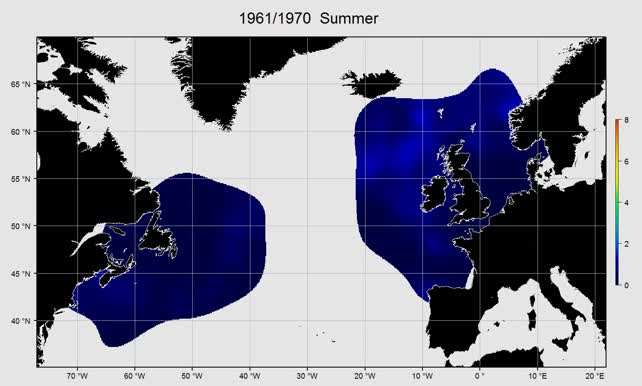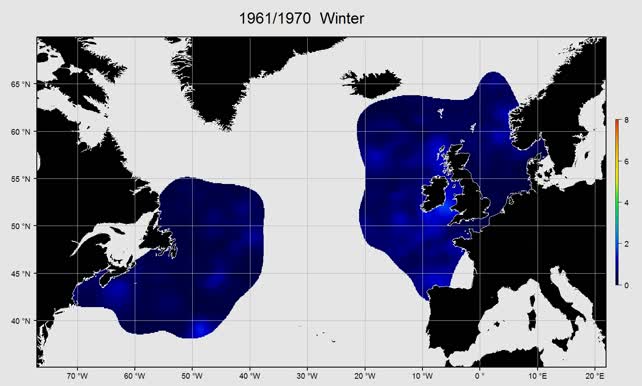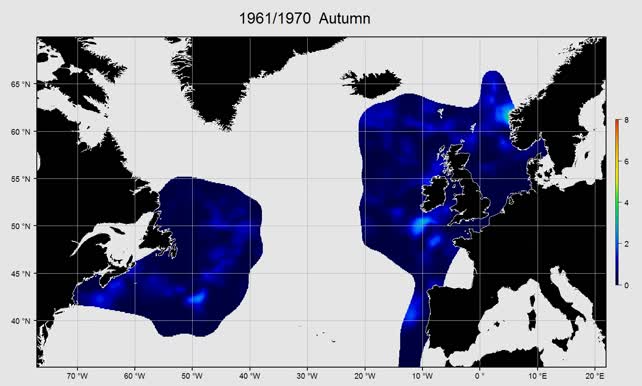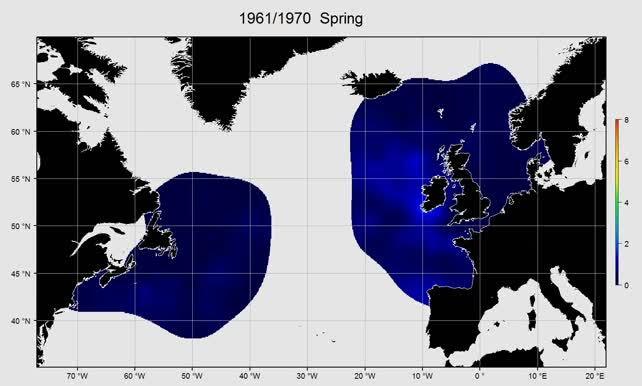| Introduction | | Species lists | | Search taxa | | Taxon tree | | Literature | | Distributions | | Statistics | | Editors | | Match taxa | | Webservice | | Log in |
WoRMS name detailsMetridia lucens Boeck, 1865
104633 (urn:lsid:marinespecies.org:taxname:104633)
alternative representation
Species
Metridia armata Brady, 1878 · unaccepted
Metridia hibernica (Brady & Robertson, 1873) · unaccepted
marine,
Boeck, A. (1865). Oversigt over de ved Norges Kyster jagttagne Copepoder henhorende til Calanidernes, Cyclopidernes og Harpactidernes Familier. [Overview of the Copepods hunted on the coast of Norway belonging to the families Calanoidae, Cyclopoidae and Harpacticodidae.]. <em>Forhandlinger i Videnskabs-Selskabet i Christiania.</em> 1864: 226-282 [for 1864 however published in 1865].
page(s): 238 [details]
Distribution Labrador to Cape Cod
Distribution Labrador to Cape Cod [details]
Walter, T.C.; Boxshall, G. (2025). World of Copepods Database. Metridia lucens Boeck, 1865. Accessed through: World Register of Marine Species at: https://www.marinespecies.org/aphia.php?p=taxdetails&id=104633 on 2025-07-16
Date action by
Nomenclatureoriginal description
Boeck, A. (1865). Oversigt over de ved Norges Kyster jagttagne Copepoder henhorende til Calanidernes, Cyclopidernes og Harpactidernes Familier. [Overview of the Copepods hunted on the coast of Norway belonging to the families Calanoidae, Cyclopoidae and Harpacticodidae.]. <em>Forhandlinger i Videnskabs-Selskabet i Christiania.</em> 1864: 226-282 [for 1864 however published in 1865]. page(s): 238 [details] basis of record Boxshall, G. (2001). Copepoda (excl. Harpacticoida), <B><I>in</I></B>: Costello, M.J. <i>et al.</i> (Ed.) (2001). <i>European register of marine species: a check-list of the marine species in Europe and a bibliography of guides to their identification. Collection Patrimoines Naturels,</i> 50: pp. 252-268 (look up in IMIS) [details] new combination reference Hays, G.C., A.J. Warner & P. Tranter. (1997). Why do the two most abundant copepods in the North Atlantic differ so markedly in their diel vertical migration behaviour? Journal of Sea Research 38(1-2):85-92., available online at https://doi.org/10.1016/S1385-1101(97)00030-0 [details] Available for editors Ecologyecology source
Brun, P., M.R. Payne & T. Kiørboe. (2017). A trait database for marine copepods. <em>Earth System Science Data.</em> 9(1):99-113., available online at https://doi.org/10.5194/essd-9-99-2017 [details] Available for editors Othercontext source (Deepsea)
Intergovernmental Oceanographic Commission (IOC) of UNESCO. The Ocean Biogeographic Information System (OBIS), available online at http://www.iobis.org/ [details]
context source (Bermuda) Wilson, C. B. (1936). Plankton of the Bermuda Oceanographic Expeditions IV. Notes on Copepoda . Zoologica Scientific Contributions of the New York Zoological Society , New York, 21(7): 89-93 [details] Available for editors additional source Brunel, P., L. Bosse & G. Lamarche. (1998). Catalogue of the marine invertebrates of the estuary and Gulf of St. Lawrence. <em>Canadian Special Publication of Fisheries and Aquatic Sciences, 126.</em> 405 pp. (look up in IMIS) [details] Available for editors additional source Roff, J.C. (1978). A guide to the marine flora and fauna of the Bay of Fundy: Copepoda: Calanoida. Fisheries and Marine Service Technical Report 823. 27 p. [details] Available for editors additional source Grice, G.D. & K. Hulsemann. (1967). Bathypelagic calanoid copepods of the western Indian Ocean. <em>Proceedings of the United States National Museum.</em> 122(3583):1-67, figs. 1-319., available online at https://doi.org/10.5479/si.00963801.122-3583.1 [details] Available for editors additional source Batchelder, H.P. & R. Williams. (1995). Individual-based modelling of the population dynamics of Metridia lucens in the North Atlantic. ICES (International Council for the Exploration of the Sea) Journal of Marine Science 52(3-4):469-482. Also issued as ICES Marine Science Symposia Vol. 200. [details] Available for editors additional source Bollens, S.M., K. Osgood, B.W. Frost & S.D. Watts. (1993). Vertical distributions and susceptibilities to vertebrate predation of the marine copepods Metridia lucens and Calanus pacificus. Limnology and Oceanography 38(8):1827-1837. [details] Available for editors additional source Bradford-Grieve, J.M. (1999). The Marine Fauna of New Zealand: Pelagic Calanoid Copepoda: Bathypontiidae, Arietellidae, Augaptilidae, Heterorhabdidae, Lucicutiidae, Metrodinidae, Phyllopodidae, Centropagidae, Pseudodiaptomidae, Temoridae, Candaciidae, Pontellidae, Sulcanidae, Acartiid National Institute of Water and Atmospheric Research (NIWA) Biodiversity Memoir, Wellington 111:1-268. [details] Available for editors additional source Bucklin, A., B.W. Frost & T.D. Kocher. (1995). Molecular systematics of six Calanus and three Metridia species (Calanoida: Copepoda). Marine Biology 121(4):655-664. [details] Available for editors additional source David, C.N. & R.J. Conover. (1961). Preliminary investigations on the physiology and ecology of luminescence in the copepod, Metridia lucens. Biological Bulletin, Woods Hole 121(1):92-107, figs. 1-7, tab. 1. (viii-1961) [details] Available for editors additional source Furuhashi, K. (1965). Occurrence of cold water copepod, Metridia lucens Boeck, in the Enshunada of the Kuroshio region. Information Bulletin on Planktology in Japan 12:49-51, figs. 1-2. (ix-1965) [details] Available for editors additional source Gibbons, S.G. (1938). Early developmental stages of Copepoda. II. Metridia lucens Boeck. Annals and Magazine of Natural History (11)2:493-497, figs. 1-4. (xi-1938) [details] Available for editors additional source Haq, S.M. (1967). Nutritional physiology of Metridia lucens and M. longa from the Gulf of Maine. <em>Limnology and Oceanography.</em> 12(1):40-51, figs. 1-3, tabs. 1-5. (i-1967). [details] Available for editors additional source Hays, G.C., A.J. Warner & P. Tranter. (1997). Why do the two most abundant copepods in the North Atlantic differ so markedly in their diel vertical migration behaviour? Journal of Sea Research 38(1-2):85-92., available online at https://doi.org/10.1016/S1385-1101(97)00030-0 [details] Available for editors additional source Hays, G.C., P.I. Webb & S.L. Frears. (1998). Diel changes in the carbon and nitrogen content of the copepod Metridia lucens. <em>Journal of Plankton Research.</em> 20(4):727-737. [details] Available for editors additional source Hays, G.C. (1995). Ontogenetic and seasonal variation in the diel vertical migration of the copepods Metridia lucens and Metridia longa. Limnology and Oceanography 40(8):1461-1465. [details] Available for editors additional source Linko, A.K. (1907). Untersuchungen über das Plankton des Barents Meeres. [Investigations on the plankton of the Barents Sea.]. <em>Wissenschaftlich praktische Murman Expedition, St. Petersburg.</em> :1-247, figs.1-21. [details] additional source Mazzocchi, M.G., G. Zagami, A. Ianora, L. Guglielmo, N. Crescenti & J. Hure. (1995). Copepods. <em>In: Guglielmo, L. & A. Ianora (eds.). Atlas of Marine Zooplankton, Straits of Magellan. Springer-Verlag, Berlin, New York.</em> 279 pp. [details] Available for editors additional source Osgood, K.E. & B.W. Frost. (1994). Ontogenetic diel vertical migration behaviors of the marine planktonic copepods Calanus pacificus and Metridia lucens. Marine Ecology Progress Series 104(1-2):13-25. [details] Available for editors additional source Othman, B.H.R. & J.G. Greenwood. (1994). A new genus with three new species of copepods from the family Diaixidae (Crustacea: Calanoida), and a redefinition of the family. Journal of Natural History, London 28(5):987-1005, figs 1-9. [details] Available for editors additional source Pesta, O. (1928). Krebstiere oder Crustacea. I: Ruderfüsser oder Copepoda (1. Calanoida, 2. Cyclopoida) (3. Ordnung) [Crustaceans or Crustacea. I: Copepods (1. Calanoida, 2. Cyclopoida) (3rd order).]. <em>In: Dahl, F. (ed.). Die Tierwelt Deutschlands und der Angrenzenden Meeresteile nach Ihren Merkmalen und nach Ihrer Lebensweise. Fischer, Jena.</em> 9:1-136, figs. 1-115. [details] Available for editors additional source Sars, G.O. (1902). Copepoda Calanoida, Parts IX & X, Temoridae, Metridiidae, Heterorhabdidae. <em>An Account of the Crustacea of Norway, with short descriptions and figures of all the species. Bergen Museum.</em> 4: 97-120, pls. 65-80. (look up in IMIS) [details] additional source Smith, S.L. & P.V.Z. Lane. (1988). Grazing of the spring diatom bloom in the New York Bight by the calanoid copepods Calanus finmarchicus, Metridia lucens, and Centropages typicus. Continental Shelf Research 8(5-7):485-510. [details] Available for editors additional source Webber, W.R., G.D. Fenwick, J.M. Bradford-Grieve, S.G. Eagar, J.S. Buckeridge, G.C.B. Poore, E.W. Dawson, L. Watling, J.B. Jones, J.B.J. Wells, N.L. Bruce, S.T. Ahyong, K. Larsen, M.A. Chapman, J. Olesen, J.S. Ho, J.D. Green, R.J. Shiel, C.E.F. Rocha, A. Lörz, G.J. Bird & W.A. Charleston. (2010). Phylum Arthropoda Subphylum Crustacea: shrimps, crabs, lobsters, barnacles, slaters, and kin. <em>in: Gordon, D.P. (Ed.) (2010). New Zealand inventory of biodiversity: 2. Kingdom Animalia: Chaetognatha, Ecdysozoa, Ichnofossils.</em> pp. 98-232 (COPEPODS 21 pp.). [details] Available for editors additional source Lee, B.D. (1966). Distribution and abundance of pelagic copepods in the Drake Passage and off the coast of Argentina, with special reference to hydrology of these areas. Ph.D. Thesis, Texas A&M University, College Station, Texas, 1-250, pls. 1-56. [details] Available for editors additional source Integrated Taxonomic Information System (ITIS). , available online at http://www.itis.gov [details] additional source ICES Zooplankton: Copepoda. sheet n° 32. [details] additional source Wilson, C.B. (1932). The copepods of the Woods Hole region, Massachusetts. <em>Bulletin of the United States National Museum.</em> 158:1-635, figs. 1-316, pls. 1-41. [details] Available for editors additional source Paulmier, G. (2016). Les Copépodes (Crustacea, Calanoida) des eaux côtières et estuariennes de la Bretagne et de la Normandie. Section des Heterarthrandria. Copepoda (Crustacea, Calanoida) from coastal and estuaries waters of the Brittany and Normandy, Section Heterarthrandria. <em>Bulletin de la Societe Linneenne de Bordeaux.</em> 151, n.ser. 44(2/3):317-335. [details] Available for editors additional source Thorp, A.C. (1980). Comparative morphology of sibling species of Metridia (Copepoda:Calanoida) M. lucens, M. pacifica and a species indeterminata from Indian Arm, British Columbia. <em>M.Sc. Thesis, University of British Columbia, Vancouver, British Columbia, Canada.</em> 75 pp., available online at http:// http://hdl.handle.net/2429/22197 [details] Available for editors  Present Present  Present in aphia/obis/gbif/idigbio Present in aphia/obis/gbif/idigbio  Inaccurate Inaccurate  Introduced: alien Introduced: alien  Containing type locality Containing type locality
Unreviewed
Biology Bioluminating species, which is rarely observed in copepod species. [details]Distribution Labrador to Cape Cod [details] Habitat upper and glacial epipelagic regions of the Gulf and estuary [details]
Marine Planktonic Copepods (Banyuls/OOB/UPMC/CNRS) Note: Including taxonomic identification plates, remarks, geographic distribution, ecological information & reference list
To Barcode of Life (219 barcodes) To Biodiversity Heritage Library (111 publications) To Biodiversity Heritage Library (57 publications) (from synonym Metridia armata Brady, 1878) To European Nucleotide Archive, ENA (Metridia lucens) To GenBank (328 nucleotides; 220 proteins) To Global Biotic Interactions (GloBI) To PESI To USNM Invertebrate Zoology Arthropoda Collection (67 records) To ITIS |






